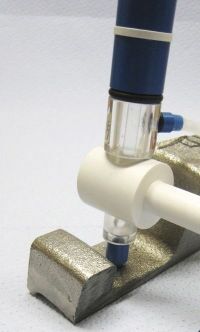Electrochemical test methods

As the corrosion of metals is usually based on electrochemical redox reactions, electrochemical test methods can be used to investigate corrosion mechanisms, corrosion susceptibility and contact corrosion risk, as well as to control the quality of coatings and predict service life. In general, it is particularly advantageous that corrosion behaviour can be recorded and evaluated very quickly with this measurement method. This is often of particular interest when it comes to developments that are hindered by sometimes-extended long-term tests.
For this purpose, we have two electrochemical measuring units from Gamry (Gamry Ref 600 and Gamry IFC 1010). Besides the simple beaker version, the following types of electrochemical measuring cells are available:
- Gamry Paint-Test Cell PTC1 having a defined sample surface area (Ø 0.8/4.2cm) with and without temperature control
= for electrochemical testing of coated and bare metal samples
- Mini measuring cell (Ø 0.1 cm/0.4 cm), which can be placed precisely and very localy on the surface to be examined (both vertically and horizontally)
= possibility of measuring on complex geometries with very fine resolution, e.g. interesting in the area of welding joints
- The Avesta cell (also called Quarfort-cell or flushed-port cell) is specifically used for pitting corrosion testing. It prevents a given electrode from crevice corrosion, so pitting initation and growth can be studied without being tampered by parasitic currents. The AVESTA - cell for flat electrodes forms an opening of 1cm² (Ø 11mm), with "crevice-free" border. The cell has a volume of 500ml and can be temperature controlled up to 80°C. In addition, the corrosion medium can be purged with e.g. air or argon during the measurement.
= Possibility to determine the critical pitting temperature of stainless steels according to ASTM G150.
- DNCS 22 is a cell set, with heating jacket (up to 80°C) and a volume of 500ml. The electrode holder is equipped with different adapter openings (Ø 5, 7, 11 and 25 mm).
= for electrochemical testing of coated and bare metal samples
